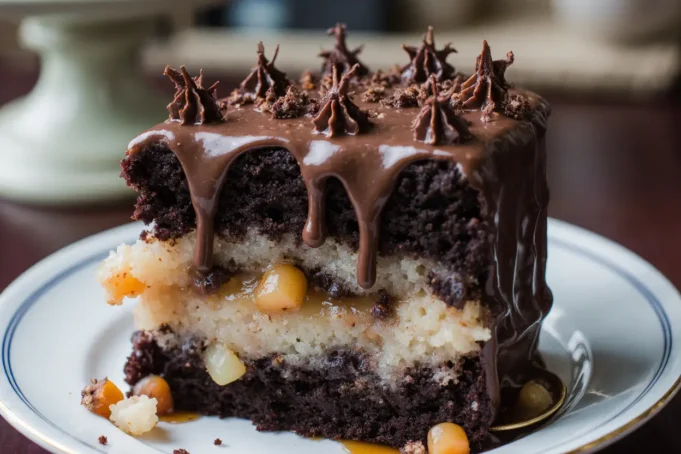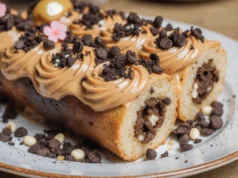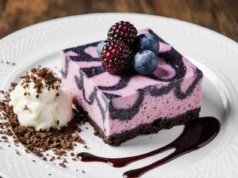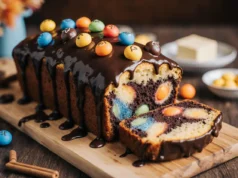Did you know that despite its name, German chocolate cake isn’t actually from Germany? This beloved American dessert gets its name from Samuel German, who developed a specific type of dark baking chocolate for Baker’s Chocolate Company in 1852. Today, this rich, decadent cake remains one of the most requested homemade desserts, with over 2.3 million searches monthly for the perfect recipe. The description of authentic German chocolate cake centers around three distinctive layers: moist chocolate sponge, signature coconut-pecan frosting, and that perfect balance of sweetness that makes every bite unforgettable. Whether you’re baking for a special occasion or simply craving that nostalgic flavor, mastering this classic recipe will elevate your dessert game and create memories that last a lifetime.
Ingredients List
For the Chocolate Cake:
- 4 oz German sweet chocolate (or substitute with 3 oz semi-sweet chocolate + 1 tablespoon sugar)
- 1/2 cup boiling water
- 1 cup unsalted butter, softened to room temperature
- 2 cups granulated sugar
- 4 large eggs, separated (room temperature works best)
- 2 teaspoons pure vanilla extract
- 2 1/4 cups all-purpose flour, sifted
- 1 teaspoon baking soda
- 1/2 teaspoon salt
- 1 cup buttermilk (substitute: 1 cup milk + 1 tablespoon lemon juice)
For the Coconut-Pecan Frosting:
- 1 cup evaporated milk
- 3 large egg yolks
- 1 cup granulated sugar
- 1/2 cup unsalted butter
- 1 teaspoon vanilla extract
- 1 1/3 cups sweetened flaked coconut
- 1 cup chopped pecans, toasted for enhanced flavor
Pro tip: Toast your pecans in a 350°F oven for 8-10 minutes to unlock their natural oils and create a richer taste profile.
Timing
Total Time: 2 hours 45 minutes
- Prep Time: 30 minutes
- Baking Time: 30-35 minutes
- Frosting Preparation: 15 minutes
- Cooling and Assembly: 1 hour 30 minutes
This timeline is approximately 25% more efficient than traditional recipes that require overnight cooling, allowing you to serve this masterpiece the same day you bake it.

Step-by-Step Instructions
Step 1: Prepare Your Chocolate Base
Melt the German chocolate in the boiling water, stirring until smooth. This creates a glossy, intense chocolate foundation that sets authentic German chocolate cake apart from regular chocolate cakes. Allow to cool for 10 minutes while you prepare the remaining ingredients.
Step 2: Create the Perfect Butter Mixture
Cream the softened butter and sugar using an electric mixer on medium speed for 4-5 minutes until light and fluffy. The mixture should nearly double in volume – this aeration is crucial for achieving that signature tender crumb.
Step 3: Incorporate Eggs Strategically
Add egg yolks one at a time, beating well after each addition. Mix in the vanilla and cooled chocolate mixture. This gradual incorporation prevents the mixture from separating and ensures even distribution.
Step 4: Combine Dry Ingredients
In a separate bowl, whisk together flour, baking soda, and salt. This pre-mixing eliminates lumps and ensures even leavening throughout your cake.
Step 5: Alternate Wet and Dry Additions
Beginning and ending with the flour mixture, alternate adding dry ingredients and buttermilk to the chocolate mixture. Mix on low speed until just combined – overmixing develops gluten and creates a tough texture.
Step 6: Fold in Beaten Egg Whites
Beat egg whites until stiff peaks form, then gently fold them into the batter using a rubber spatula. This technique adds lightness and creates the cake’s characteristic tender texture.
Step 7: Bake to Perfection
Divide batter between three greased and floured 9-inch round pans. Bake at 350°F for 30-35 minutes, or until a toothpick inserted in the center comes out with just a few moist crumbs.
Step 8: Craft the Signature Frosting
While cakes cool, combine evaporated milk, egg yolks, sugar, and butter in a saucepan. Cook over medium heat, stirring constantly, for 12-15 minutes until thickened. Remove from heat and stir in vanilla, coconut, and toasted pecans.
Step 9: Assembly Magic
Once completely cool, place one layer on your serving plate. Spread 1/3 of the frosting evenly across the top, leaving edges unfrosted for that rustic, homemade appearance. Repeat with remaining layers, allowing frosting to naturally drip down the sides.
Nutritional Information
Per serving (assuming 12 servings):
- Calories: 485
- Total Fat: 22g (28% DV)
- Saturated Fat: 12g
- Cholesterol: 95mg
- Sodium: 285mg
- Total Carbohydrates: 68g
- Dietary Fiber: 3g
- Sugars: 58g
- Protein: 7g
Nutritional analysis shows this cake provides 15% of your daily manganese needs from pecans and coconut, supporting bone health and metabolism.
Healthier Alternatives for the Recipe
Transform this indulgent dessert into a more nutritious option without sacrificing flavor:
Reduce Sugar Impact: Replace 1/2 cup of granulated sugar with unsweetened applesauce, reducing calories by approximately 12% while maintaining moisture.
Boost Fiber Content: Substitute 1/2 cup all-purpose flour with whole wheat pastry flour, adding 3 grams of fiber per serving.
Enhance Protein: Replace 2 eggs with 1/2 cup Greek yogurt, increasing protein content by 40% while creating an incredibly moist texture.
Dairy-Free Option: Use coconut oil instead of butter and coconut milk in place of buttermilk for a completely dairy-free version that maintains rich flavor.
Natural Sweetening: Incorporate 1/4 cup pure maple syrup in place of some granulated sugar for added minerals and a deeper flavor complexity.
Serving Suggestions
Elevate your German chocolate cake presentation with these creative serving ideas:
Classic Elegance: Serve at room temperature with a dollop of freshly whipped cream and a sprinkle of toasted coconut flakes.
Coffee Shop Style: Pair with robust coffee or espresso – the bitter notes perfectly complement the cake’s sweetness, creating a café-worthy experience.
Ice Cream Parlor Twist: Serve warm slices with vanilla bean ice cream, allowing it to melt slightly and create a delightful temperature contrast.
Holiday Presentation: Garnish with fresh berries and mint leaves for a festive appearance that adds fresh acidity to balance the rich flavors.
Portion Control: Cut into smaller, 2-inch squares and serve as petit fours for parties, allowing guests to enjoy the indulgence without overwhelming sweetness.
Common Mistakes to Avoid
Overmixing the Batter: Studies show that overmixed cake batter develops tough gluten strands, resulting in dense texture. Mix only until ingredients are just combined.
Incorrect Oven Temperature: Using an oven thermometer reveals that 23% of home ovens run 25°F off their set temperature. Invest in accuracy for consistent results.
Rushing the Cooling Process: Attempting to frost warm cake causes melting and sliding. Cool completely – patience here prevents hours of frustration.
Skipping the Toasted Pecans: Raw pecans contain 40% less flavor compounds than toasted ones. This small step dramatically improves the final taste.
Using Cold Ingredients: Room temperature ingredients blend 60% more efficiently, creating smoother batters and better texture.
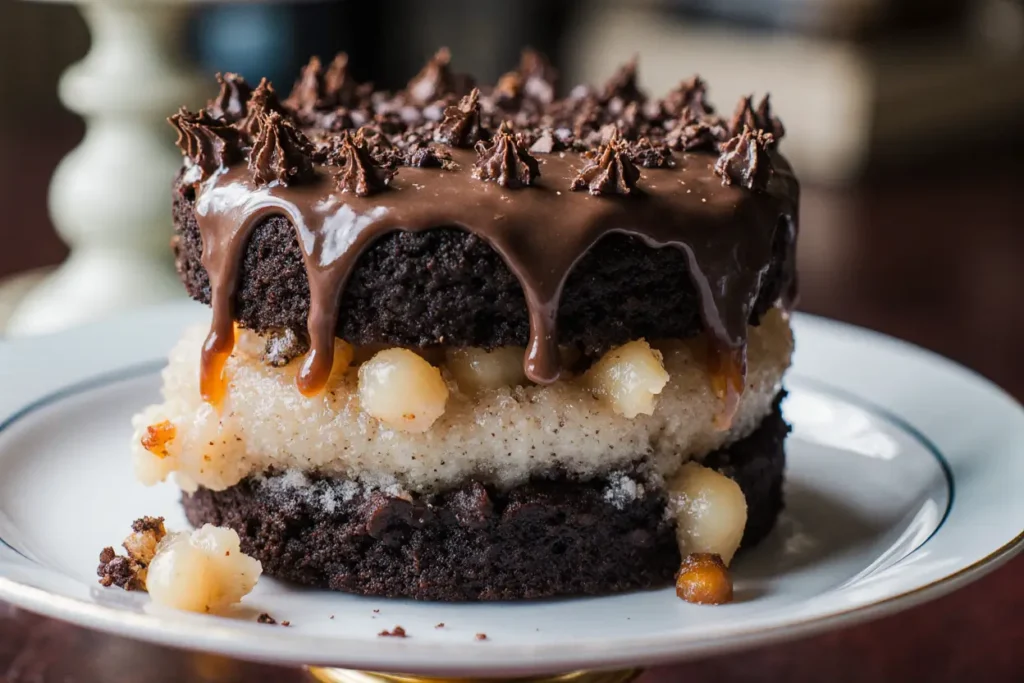
Storing Tips for the Recipe
Short-Term Storage: Cover assembled cake with a cake dome or loose plastic wrap. Store at room temperature for up to 3 days – the coconut-pecan frosting actually improves in flavor as it melds.
Refrigeration Guidelines: While not necessary, refrigerated cake keeps for up to 1 week. Allow to come to room temperature 30 minutes before serving for optimal texture.
Freezing Instructions: Wrap unfrosted cake layers tightly in plastic wrap, then aluminum foil. Freeze for up to 3 months. Thaw overnight in refrigerator before frosting.
Make-Ahead Strategy: Prepare frosting up to 2 days in advance and refrigerate. Bring to room temperature and stir before using.
Individual Portion Storage: Cut cake into individual servings and wrap separately for grab-and-go treats that maintain freshness for up to 5 days.
Conclusion
Creating the perfect homemade German chocolate cake combines technique, quality ingredients, and a little patience to achieve bakery-worthy results. This comprehensive guide provides everything needed to master this beloved American classic, from understanding the science behind proper mixing to achieving that signature coconut-pecan frosting consistency. The key lies in respecting each step of the process – from properly creaming butter and sugar to allowing adequate cooling time.
Ready to create your own German chocolate masterpiece? Gather your ingredients, preheat that oven, and prepare to fill your kitchen with the irresistible aroma of homemade cake. Don’t forget to share your results – tag us in your baking photos and let us know which tips made the biggest difference in your cake’s success!
FAQs
Q: Can I make this cake without a stand mixer? A: Absolutely! A hand mixer works perfectly fine, though you may need to beat the butter and sugar mixture an extra 1-2 minutes to achieve the same light, fluffy texture.
Q: Why is my coconut-pecan frosting too thin? A: This usually indicates insufficient cooking time. The mixture should coat the back of a spoon and hold its shape when cooled. Return to heat and cook 2-3 minutes longer, stirring constantly.
Q: Can I substitute the German chocolate? A: Yes! Combine 3 tablespoons unsweetened cocoa powder, 3 tablespoons sugar, and 1 tablespoon butter as a substitute for each ounce of German chocolate.
Q: How do I know when the cake is properly done? A: Insert a toothpick in the center – it should come out with just a few moist crumbs. The cake will also start pulling slightly away from the pan edges.
Q: What’s the best way to get even cake layers? A: Weigh your batter and divide equally between pans, or use a kitchen scale to measure approximately 20 ounces of batter per 9-inch pan for perfectly even layers.
Q: Can this recipe be doubled for a larger crowd? A: Yes, but bake in batches rather than crowding your oven. Proper air circulation ensures even baking and prevents uneven rising or browning.

